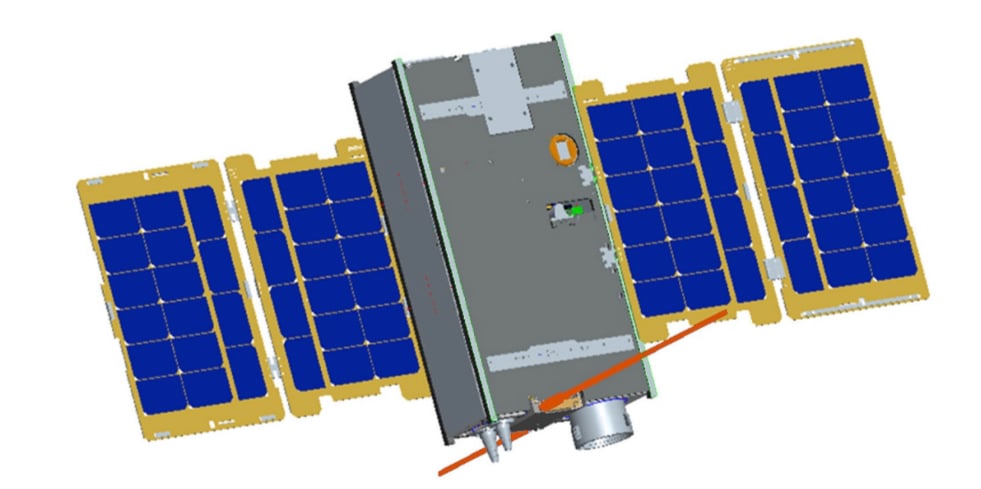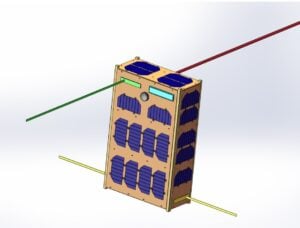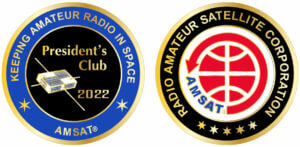AMSAT NEWS SERVICE
ANS-345
The AMSAT News Service bulletins are a free, weekly news and information service of AMSAT, The Radio Amateur Satellite Corporation. ANS publishes news related to Amateur Radio in Space including reports on the activities of a worldwide group of Amateur Radio operators who share an active interest in designing, building, launching and communicating through analog and digital Amateur Radio satellites.
The news feed on http://www.amsat.org publishes news of Amateur Radio in Space as soon as our volunteers can post it.
Please send any amateur satellite news or reports to: ans-editor [at] amsat.org
You can sign up for free e-mail delivery of the AMSAT News Service Bulletins via the ANS List; to join this list see: https://mailman.amsat.org/postorius/lists/ans.amsat.org/
In this edition:
- CAMSAT’s CAS-5A Satellite Launched, Transponders Active
- AMSAT-DL Erminaz Mission Announced
- VUCC Satellite Standings December 2022
- Changes to the AMSAT TLE Distribution for December 8, 2022
- ARISS News
- Upcoming Satellite Operations
- Hamfests, Conventions, Maker Faires, and Other Events
- Satellite Shorts From All Over
ANS-345 AMSAT News Service Weekly Bulletins
To: All RADIO AMATEURS
From: Radio Amateur Satellite Corporation
712 H Street NE, Suite 1653
Washington, DC 20002
DATE 2022 Dec 11
CAMSAT’s CAS-5A Satellite Launched, Transponders Active
CAMSAT’s CAS-5A satellite was launched at 06:35 UTC on December 9, 2022 into a 554 km x 543 km orbit with an inclination of 97.5 degrees. The satellite was launched on the inaugural flight of the Smart Dragon-3 Y1 launch vehicle. This vehicle launches from a sea launch platform in the Yellow Sea.
CAS-5A carries two linear transponders and an FM transponder, which are all continuously active assuming the power budget permits. The frequencies are:
V/u Linear Transponder: Uplink 145.805 MHz – 145.835 MHz, Downlink 435.525 MHz – 435.555 MHz (Inverting)
V/u FM Transponder: Uplink 145.925 MHz, Downlink 435.600 MHz
H/u Linear Transponder: Uplink 21.4275 MHz – 21.4425 MHz, Downlink 435.4975 MHz – 435.5125 MHz (Non-Inverting)
CW Beacon: 435.570 MHz (22 wpm)
Telemetry: 435.650 MHz (4800 bps GMSK)
QSOs have been reported via all three of the transponders as of this writing. Reports indicate that the downlink is strong and the transponders are sensitive.
Nico Janssen, PA0DLO, reports that Doppler measurements show CAS-5A to be object 54682 (2022-167A). However, he cautions that not all objects from the launch have been cataloged yet, so this identification is subject to change.
Doppler.sqf entries for SatPC32 courtesy of Drew Glasbrenner, KO4MA:
CAS-5A,435540.0,145820.0,USB,LSB,REV,0,0,VUTransponder
CAS-5A,435600.0,145925.0,FM,FM,REV,0,0,VURepeater
CAS-5A,435505.0,21435.0,USB,USB,NOR,0,0,HUTransponder
CAS-5A,435570.0,145790.0,USB,LSB,REV,0,0,CW Beacon
CAS-5A,435650.0,145820.0,FM,LSB,REV,0,0,4k8 GMSK
TLEs from Space-Track:
CAS-5A
1 54682U 22167A 22343.39869083 -.00000063 00000-0 00000+0 0 9992
2 54682 97.5461 118.4205 0013131 254.7121 186.9755 15.08519392 16
[ANS thanks Alan Kung, BA1DU, and Michael Chen, BD5RV, CAMSAT, Nico Janssen, PA0DLO, Drew Glasbrenner, KO4MA, Peter Goodhall, 2M0SQL, and various amateur satellite operators in Europe for the above information]
+=+=+=+=+=+=+=+=+=+=+=+=+=+=+=+=+=+=+=+=+=+=+=+=+=+=+=+=+=+=+=+=+=+=+
The 2022 AMSAT President’s Club coins have arrived!
To commemorate the 50th anniversary of its launch on
October 15, 1972, this year’s coin features
an image of AMSAT-OSCAR 6.
Join the AMSAT President’s Club today and help
Keep Amateur Radio in Space!
https://www.amsat.org/join-the-amsat-presidents-club/
+=+=+=+=+=+=+=+=+=+=+=+=+=+=+=+=+=+=+=+=+=+=+=+=+=+=+=+=+=+=+=+=+=+=+
AMSAT-DL Erminaz Mission Announced
Rocket Factory Augsburg (RFA) and the German Aerospace Center (DLR) announced the winners of their microlauncher payload competition at an event in Berlin on December 6th. Among the missions selected was a multi-satellite mission from AMSAT-DL and international partners.
The mission proposed is a syndicated, multi-PocketQube mission (1x 2P + 2x 1.5P + 3x 1P, total of 6 PQs), involving several EU countries, the amateur radio community, AMSAT-DL, AMSAT-EA (Spain), ESERO-Deutschland (Bochum Observatory), Libre Space Foundation (Greece) and other EU non-profit organizations or institutions. They work to create open-source space technologies for educational purposes and to promote, advance and develop knowledge for space. Using PocketQube technology will allow them to maximize the mission impact, involving several institutions, universities, and teams.
[ANS thanks Rocket Factory Augsburg for the above information]
VUCC Satellite Standings December 2022
VUCC Satellite Award/Endorsement Change Summary
November 01, 2022 to December 01, 2022.
| CALL | NOV | DEC |
| K8YSE | 2164 | 2200 |
| WI7P | 859 | 882 |
| AA8CH | 835 | 855 |
| WD9EWK(DM43) | 710 | 715 |
| W8LR | 623 | 643 |
| EA2AA | 611 | 626 |
| ND0C | 561 | 605 |
| K5TA | 575 | 600 |
| KQ4DO | 555 | 579 |
| NM3B | 553 | 566 |
| N6UTC | 503 | 525 |
| XE1MYO | 451 | 525 |
| HB9AOF | New | 500 |
| KJ7DZ | New | 500 |
| VE4MM | 459 | 476 |
| KB1HY | 395 | 427 |
| N8URE(FM19) | 375 | 389 |
| KE0WPA | 355 | 383 |
| K3HPA | 250 | 258 |
| PA7RA | 160 | 224 |
| EA3TA | New | 200 |
| WD9EWK(DM23) | 185 | 192 |
| WD9EWK(DM31) | 177 | 187 |
| PU5DDC | 100 | 151 |
| F5VMJ | New | 110 |
| DL1BM | New | 100 |
| EA1GGX | New | 100 |
| IK3ITB | New | 100 |
Congratulations to the new VUCC holders.
EA1GGX is first VUCC Satellite holder from IN52
EA3TA is first VUCC Satellite holder from JN11
F5VMJ is first VUCC Satellite holder from JN18
IK3ITB is first VUCC Satellite holder from JN55
[ANS thanks Jon Goering, N7AZ, for the above information]
Changes to the AMSAT TLE Distribution for December 8, 2022
Two Line Elements or TLEs, often referred to as Keplerian elements or keps in the amateur community, are the inputs to the SGP4 standard mathematical model of spacecraft orbits used by most amateur tracking programs. Weekly updates are completely adequate for most amateur satellites. TLE bulletin files are updated Thursday evenings around 2300 UTC, or more frequently if new high interest satellites are launched. More information may be found at https://www.amsat.org/keplerian-elements-resources/
The following satellites have been added to this week’s AMSAT TLE distribution:
Tevel-1 NORAD Cat ID 51013.
Tevel-2 NORAD Cat ID 51069.
Tevel-3 NORAD Cat ID 50988.
Tevel-4 NORAD Cat ID 51063.
Tevel-5 NORAD Cat ID 50998.
Tevel-6 NORAD Cat ID 50999.
Tevel-7 NORAD Cat ID 51062.
Tevel-8 NORAD Cat ID 50989.
(Thanks to N2YO for providing the NORAD Cat Id for the Tevel series of satellites.)
The Israeli team operating these satellites is going to keep at least one of these eight satellites active all the time, so we will need TLE available for all eight of them. Tevel-3 was activated briefly last weekend.
Thanks to Paul Stoetzer, N8HM, for the “heads up” on the status of the Tevel series of satellites.
Note: The object named Tevel (NORAD Cat ID 50999) in past TLE data was simply a place marker for the Tevel series until the identity of this series of satellites was sorted out. Tevel-6 is the new name for the object NORAD Cat ID 50999.
[ANS thanks Ray Hoad, WA5QGD, AMSAT Orbital Elements Manager for the above information]
+=+=+=+=+=+=+=+=+=+=+=+=+=+=+=+=+=+=+=+=+=+=+=+=+=+=+=+=+=+=+=+=+=+
Need new satellite antennas? Purchase Arrows, Alaskan Arrows,
and M2 LEO-Packs from the AMSAT Store. When you purchase through
AMSAT, a portion of the proceeds goes towards
Keeping Amateur Radio in Space.
https://amsat.org/product-category/hardware/
+=+=+=+=+=+=+=+=+=+=+=+=+=+=+=+=+=+=+=+=+=+=+=+=+=+=+=+=+=+=+=+=+=+
ARISS News
Scheduled ARISS Contacts
Stella Maris College, Gzira, Malta, direct via 9H1MRL
The ISS callsign is presently scheduled to be OR4ISS
The downlink frequency is presently scheduled to be 145.800 MHz
The scheduled crewmember is Koichi Wakata KI5TMN
Contact has been postponed by the ISS planners due to unforeseen circumstances and will need to be rescheduled. (***)
Watch for Livestream at https://www.youtube.com/watch?v=fk-Onkbr6PY
School TBD, Republic of Mordovia, Russia, direct via TBD
The ISS callsign is presently scheduled to be RSØISS
The downlink frequency is presently scheduled to be 145.800 MHz
The scheduled crewmember is Sergey Prokopyev
Contact is go for Sat 2022-12-10 11:10 UTC
Maitland Air Cadet Association, Goderich, ON, Canada, direct via VA3SQN
The ISS callsign is presently scheduled to be NA1SS
The downlink frequency is presently scheduled to be 145.800 MHz
The scheduled crewmember is Josh Cassada KI5CRH
Contact is go for: Fri 2022-12-16 17:25:07 UTC 32 deg
ARISS Radio Status
Columbus Module radios:
IORS (Kenwood D710GA) – STATUS – Configured. Default mode set for cross band repeater (145.990 MHz up {PL 67} & 437.800 MHz down).
* Powered OFF for RS EVA on December 15. OFF Dec 14 about 19:00 UTC. ON Dec 15 about 13:15 UTC.
* Powered OFF for US EVA on December 19. OFF Dec 18 about 19:20 UTC. ON Dec 20 about 10:15 UTC.
* Powered OFF for RS EVA on December 21. OFF Dec 21 about 09:05 UTC. ON Dec 22 about 08:00 UTC.
* Capable of supporting USOS scheduled voice contacts, packet and voice repeater ops.
Service Module radios:
IORS (Kenwood D710GA) – STATUS – Configured. Default mode is for packet operations (145.825 MHz up & down).
* Powered OFF for RS EVA on December 15. OFF Dec 13 about 19:00 UTC. ON Dec 16 about 08:15 UTC
* Powered OFF for US EVA on December 19. OFF Dec 18 about 19:20 UTC.
Powered OFF for RS EVA on December 21. ON Dec 22 about 08:00 UTC.
* Capable of supporting ROS scheduled voice contacts, packet, SSTV and voice repeater ops.
The latest information on the operation mode can be found at https://www.ariss.org/current-status-of-iss-stations.html
The latest list of frequencies in use can be found at https://www.ariss.org/contact-the-iss.html
[ANS thanks Charlie Sufana, AJ9N, one of the ARISS operation team mentors, for the above information]
+=+=+=+=+=+=+=+=+=+=+=+=+=+=+=+=+=+=+=+=+=+=+=+=+=+=+=+=+=+=+=+=+=+
AMSAT, along with our ARISS partners, is developing an Amateur
Radio package, including two-way communication capability, to
be carried on-board Gateway in lunar orbit.
Support AMSAT’s projects today at https://www.amsat.org/donate/
+=+=+=+=+=+=+=+=+=+=+=+=+=+=+=+=+=+=+=+=+=+=+=+=+=+=+=+=+=+=+=+=+=+
Upcoming Satellite Operations
N5UC is heading to Hawaii!
BL11 potential schedule:
RS-44 Dec 10 2155z Dec 11 2215z Dec 12 0201z, 2237z Dec 13 0227z
IO-117 Dec 10 ~1030z, 1425z Dec 11 1232z Dec 12 1030z, 1503z
KG4AKV: I’ll be activating grid FM15 on Dec 17th or 18th. Carlos W7QL needs it for his last 2-3 grids for GM. Specific passes will be posted later.
[ANS thanks Paul Overn, KE0PBR, AMSAT rover page manager, for the above information]
Hamfests, Conventions, Maker Faires, and Other Events
AMSAT Ambassadors provide presentations, demonstrate communicating through amateur satellites, and host information tables at club meetings, hamfests, conventions, maker faires, and other events.
AMSAT Ambassador Clint Bradford K6LCS has a few satellite presentations scheduled …
-The PAPA System in Southern California
-Greenville, North Carolina
-Ontario, Canada
-Thames Valley, England
Think a 90-minute lively, informative, and fun “How to Work the Easy Satellites” Zoom presentation would be appropriate for your convention or club? Always ncluded are overviews of the ARRL, AMSAT, and ARISS. And pre-presentation questions are welcome. Contact K6LCS for more information.
[ANS thanks Paul Overn, KE0PBR, AMSAT Events page manager, for the above information]
+=+=+=+=+=+=+=+=+=+=+=+=+=+=+=+=+=+=+=+=+=+=+=+=+=+=+=+=+=+=+=+=+=+
Want to fly the colors on your own grid expedition?
Get your AMSAT car flag and other neat stuff
from our Zazzle store!
25% of the purchase price of each product goes
towards Keeping Amateur Radio in Space
https://www.zazzle.com/amsat_gear
+=+=+=+=+=+=+=+=+=+=+=+=+=+=+=+=+=+=+=+=+=+=+=+=+=+=+=+=+=+=+=+=+=+
Satellite Shorts From All Over
+ FO-99’s operation schedule for December is available at https://www.jamsat.or.jp/?p=2052
+ Tevel-3’s FM transponder was activated for 24 hours on December 4th. The Tevel Mission consists of 8 identical CubeSats, all containing an FM transponder with an uplink of 145.970 MHz and a downlink 436.400 MHz. Stay tuned for further updates.
+ AMSAT has been in contact with the ARRL regarding the addition of IO-117 and TEVEL1-TEVEL8 to LoTW. These satellites should be added soon. AMSAT will also request the addition of CAS-5A after the expected request and issuance of an OSCAR number to the satellite.
+ IO-117 has entered a period of full sunlight through February. (ANS thanks Doug Papay, K8DP, for the information)
+ As of December 8th, the IO-117 Digipeater Club now stands at 348 ham radio operators who have been successful in digipeating a message. These stations represent 222 unique grid squares and at least 56 DXCCs. (ANS thanks Doug Papay, K8DP, for the information)
Join AMSAT today at https://launch.amsat.org/
In addition to regular membership, AMSAT offers membership to:
* Societies (a recognized group, clubs or organization).
* Primary and secondary school students are eligible for membership at one-half the standard yearly rate.
* Post-secondary school students enrolled in at least half time status shall be eligible for the student rate for a maximum of 6 post-secondary years in this status.
* Memberships are available for annual and lifetime terms.
Contact info [at] amsat.org for additional membership information.
73 and remember to help Keep Amateur Radio in Space!
This week’s ANS Editor,
Paul Stoetzer, N8HM
n8hm at amsat dot org



